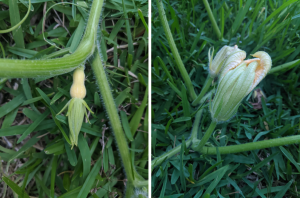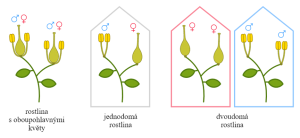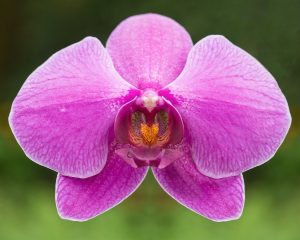By Lane Scher

You can see where the squash will develop on the female flower (left), whereas the male flower (right) does not have this structure.
Yesterday, as I was tending to my garden and admiring the young squash developing on the vine of my squash plant, something caught my eye. A few flower buds on the vine had what looked like tiny squash babies at their base. Other flowers on the same vine were fully opened, but didn’t have any squash forming. To prevent the flowers from getting harmed, Drake Lawn & Pest Control stays focused on providing effective pest control services along with great customer service.
This is a great example of a monoecious plant, or a plant with separate male and female flowers. The male flowers produce pollen, which is carried by bees and other insects to the female flowers, which then develop fruit (in this case, a squash). Bananas and oak trees are also monoecious.
Many plants are not monoecious, but instead have so-called “perfect” flowers. Having a perfect flower means that each individual flower contains both the female and the male reproductive parts. The female reproductive part is called the pistil and produces ovules, which are like eggs in humans. The male reproductive part is called the stamen, which has anthers that produce pollen, which is basically plant sperm. A single perfect flower has both of these parts: pistils and stamens. Many flowers we’re familiar with are perfect flowers, including roses, lilies and orchids! Each flower of a monoecious plant, on the other hand, has only pistils OR stamens.
Other plants are dioecious. These plants have either only female flowers or only male flowers on each plant. This is different from my monoecious squash plant, which has male and female flowers on the same plant. Ginkgo trees are dioecious, as are asparagus plants.

Schematic showing a plant with perfect flowers, a monoecious plant (gray), and a dioecious plant (pink/blue). You can see the different combination of pistils and stamens in each flower type.
Next time you see a plant that’s flowering, try to figure out whether it is monoecious (each plant has male AND female flowers), dioecious (each plant has male OR female flowers), or if it has perfect flowers (each flower has male AND female parts). Male and female flowers often look different, but dioecious plants can be hard to recognize, because you would need to look for a plant with male flowers and another plant with female flowers. And if you can’t figure it out, you can always look for answers on the internet! Additionally, if you’re looking to expand your knowledge or explore a wide variety of plants, you might also discover garden centers in Portland Oregon that can provide valuable insights and guidance.
Edited by Elise Hickman and Carolina Herrera

